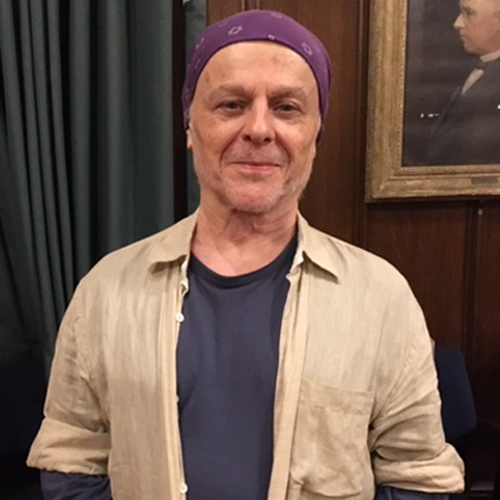
(above) © slayer87 / Adobe Stock
Dream Hacking and SkyDance
Vision Lab in residence at Center for the Study of World Religions, Harvard Divinity School
Cambridge, MA, 2018
Cambridge, MA, 2018
Dream-Hacking. Adam Haar Horowitz.
Sleep is a forgotten country of the mind. A vast majority of our technologies are built for our waking state, even though a third of our lives are spent asleep. Current technological interfaces miss an opportunity to access the unique, imaginative, elastic cognition ongoing during dreams and semi-lucid states. In turn, each of us misses an opportunity to use interfaces to influence our own processes of memory consolidation, creative insight generation, gist extraction, and emotion regulation that are so deeply sleep-dependent. In this project, we explore ways to augment human creativity by extending, influencing, and capturing dreams in Stage 1 sleep. It is currently impossible to force ourselves to be creative because so much creative idea association and creative incubation happens in the absence of executive control and directed attention. Sleep offers an opportunity for prompting creative thought in the absence of directed attention, if only dreams can be controlled. Scientific Background. During sleep onset, a window of opportunity arises in the form of hypnagogia, a semi-lucid sleep state where we all begin dreaming before we fall fully unconscious. Hypnagogia is characterized by phenomenological unpredictability, distorted perception of space and time, and spontaneous, fluid idea association. Edison, Tesla, Poe, and Dalí each accessed this state by napping with a steel ball in hand to capture creative ideas generated in hypnagogic microdreams when it dropped to the floor below #human-computer interaction #art #artificial intelligence #augmented reality #cognition #consumer electronics #health #human-machine interaction #learning #open source #wearable computing #interfaces #3d printing #social robotics #creativity #technology #cognitive science #wellbeing
![]()
![]()
![]()
![]()
Sleep is a forgotten country of the mind. A vast majority of our technologies are built for our waking state, even though a third of our lives are spent asleep. Current technological interfaces miss an opportunity to access the unique, imaginative, elastic cognition ongoing during dreams and semi-lucid states. In turn, each of us misses an opportunity to use interfaces to influence our own processes of memory consolidation, creative insight generation, gist extraction, and emotion regulation that are so deeply sleep-dependent. In this project, we explore ways to augment human creativity by extending, influencing, and capturing dreams in Stage 1 sleep. It is currently impossible to force ourselves to be creative because so much creative idea association and creative incubation happens in the absence of executive control and directed attention. Sleep offers an opportunity for prompting creative thought in the absence of directed attention, if only dreams can be controlled. Scientific Background. During sleep onset, a window of opportunity arises in the form of hypnagogia, a semi-lucid sleep state where we all begin dreaming before we fall fully unconscious. Hypnagogia is characterized by phenomenological unpredictability, distorted perception of space and time, and spontaneous, fluid idea association. Edison, Tesla, Poe, and Dalí each accessed this state by napping with a steel ball in hand to capture creative ideas generated in hypnagogic microdreams when it dropped to the floor below #human-computer interaction #art #artificial intelligence #augmented reality #cognition #consumer electronics #health #human-machine interaction #learning #open source #wearable computing #interfaces #3d printing #social robotics #creativity #technology #cognitive science #wellbeing
SkyDance. Januar Ciel.
Arts and education via contemplative movement practices and dynamic improvisational dance and music, integrated with planetary and astrological awareness
Arts and education via contemplative movement practices and dynamic improvisational dance and music, integrated with planetary and astrological awareness
The research, creativity and teachings of SkyDance Mandala offer practices of contemplative and dynamic cyclic and spiraling movement and dance. This is an integral part of an organic foundation for a whole systems and astrological approach to scoring and creating structured and improvised dance, voice and music. Through relaxed and vibrant practice, we explore awareness within the knowledge of planetary cycles and systems. The SkyDance practices bring specialized focus to our experience of the integral cyclic and spiraling nature within us, as it is within the earth, our solar system, our galaxy, the universe and all.

Januar Ciel: Dancer; long-standing work with experimental forms of dance such as contact improvisation; work currently embodies and integrates astrological gesture, ritual, Tibetan Buddhist practices. Rudyhar has been a significant influence on his thinking/being. Interested in sustainable community practices and care.

Adam Haar Horowitz is a PhD student in MIT Media Lab's Fluid Interfaces Group. His work aims to augment human awareness, translating advances in neuroscience into design of interventions and experiences. Currently, his research focuses on sleep and embodied cognition.

Kythe Heller is a poet, artist, and doctoral student in Comparative Religion at Harvard University, with a secondary field in Critical Media Studies. She is author of the poetry collections Immolation and The Thunder Perfect Mind, and of critical studies published in White Light: Media, Culture, Politics (Cambridge UP) and Quo Anima: Innovation and Spirituality in Contemporary Poetry (U of Akron Press).